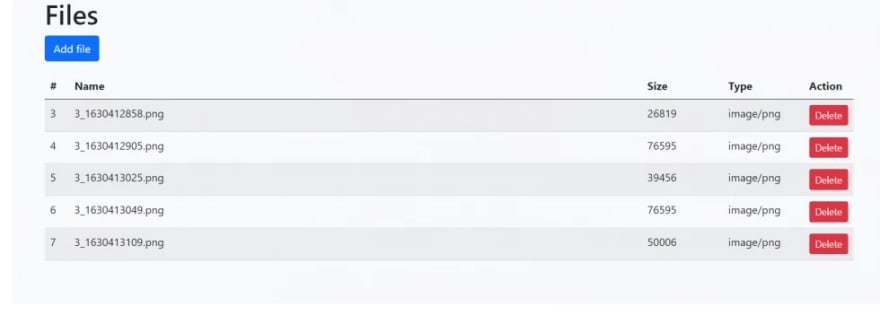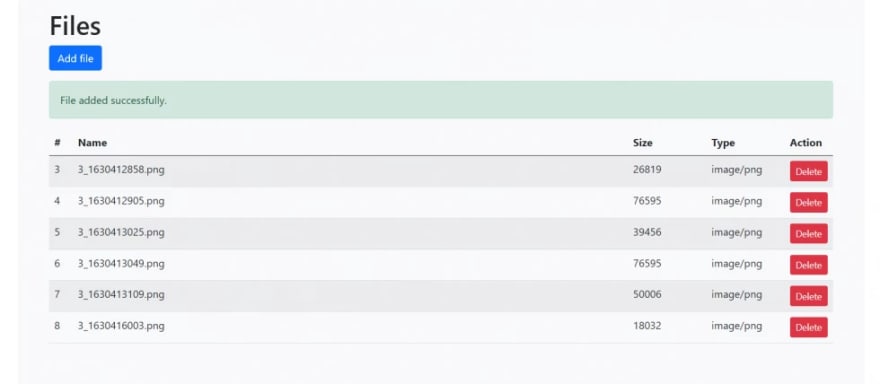An Interest In:
Web News this Week
- April 25, 2024
- April 24, 2024
- April 23, 2024
- April 22, 2024
- April 21, 2024
- April 20, 2024
- April 19, 2024
Laravel 8 File Upload Example
Originally posted @ https://codeanddeploy.com visit and download the sample code: https://codeanddeploy.com/blog/laravel/laravel-8-file-upload-example
In this post, I will be going to share how to implement a simple Laravel 8 file upload with a database implementation. We will save the generated file name base on time, size, mime-type, and associate it with the current user logged. When developing an application using Laravel usually the file upload is always present even on a simple system.
Just follow my simple steps and learn from them.
I assume that you have your Laravel 8 Project already in your local so we will skip that process. For more information on how to install Laravel just visit their documentation.
Okay, let's start.
Step 1: Create file upload migrations
First, we will create our files table migrations for our File model. Run the following command to do it:
php artisan make:migration create_files_tableThen we will add our migrations field. See below the complete code for our migrations.
<?phpuse Illuminate\Database\Migrations\Migration;use Illuminate\Database\Schema\Blueprint;use Illuminate\Support\Facades\Schema;class CreateFilesTable extends Migration{ /** * Run the migrations. * * @return void */ public function up() { Schema::create('files', function (Blueprint $table) { $table->id(); $table->unsignedBigInteger('user_id'); $table->string('name'); $table->string('type'); $table->string('size'); $table->timestamps(); $table->foreign('user_id') ->references('id') ->on('users') ->onDelete('cascade'); }); } /** * Reverse the migrations. * * @return void */ public function down() { Schema::dropIfExists('files'); }}Next, you have to run:
php artisan migrateStep 2: Create file upload controller and model
Use the command below to create your FileController with File model:
php artisan make:controller FilesController --model=FileStep 3: Create file upload routes
Now, let's create your routes for our file upload:
/*** File Upload Routes*/Route::get('/files', 'FilesController@index')->name('files.index');Route::get('/files/add', 'FilesController@create')->name('files.create');Route::post('/files/add', 'FilesController@store')->name('files.store');Step 4: Setup Model
Next, we will set up our File model. See below the completed setup.
<?phpnamespace App\Models;use Illuminate\Database\Eloquent\Factories\HasFactory;use Illuminate\Database\Eloquent\Model;class File extends Model{ protected $table = 'files'; protected $fillable = [ 'user_id', 'name', 'type', 'size' ]; use HasFactory;}Step 5: Setup Controller
Kindly see below the complete code of our controller including the file upload in store() method.
<?phpnamespace App\Http\Controllers;use App\Models\File;use Illuminate\Http\Request;use Illuminate\Http\UploadedFile;use App\Http\Requests\StoreFileRequest;class FilesController extends Controller{ /** * Display a listing of the resource. * * @return \Illuminate\Http\Response */ public function index() { $files = File::all(); return view('files.index', [ 'files' => $files ]); } /** * Show the form for creating a new resource. * * @return \Illuminate\Http\Response */ public function create() { return view('files.create'); } /** * Store a newly created resource in storage. * * @param StoreFileRequest $request * @return \Illuminate\Http\Response */ public function store(StoreFileRequest $request) { $fileName = auth()->id() . '_' . time() . '.'. $request->file->extension(); $type = $request->file->getClientMimeType(); $size = $request->file->getSize(); $request->file->move(public_path('file'), $fileName); File::create([ 'user_id' => auth()->id(), 'name' => $fileName, 'type' => $type, 'size' => $size ]); return redirect()->route('files.index')->withSuccess(__('File added successfully.')); }}Step 6: Create StoreFileRequest
Now let's create a request class for a store/uploading file. Run the command below:
php artisan make:request StoreFileRequestAfter the StoreFileRequest class is generated kindly check the code below for our validation:
<?phpnamespace App\Http\Requests;use Illuminate\Foundation\Http\FormRequest;class StoreFileRequest extends FormRequest{ /** * Determine if the user is authorized to make this request. * * @return bool */ public function authorize() { return true; } /** * Get the validation rules that apply to the request. * * @return array */ public function rules() { return [ 'file' => 'required|file|mimes:jpg,jpeg,bmp,png,doc,docx,csv,rtf,xlsx,xls,txt,pdf,zip' ]; }}Step 7: Create View
First, we will create our index.blade.php see below the complete code:
@extends('layouts.app-master')@section('content') <div class="bg-light p-5 rounded"> <h1>Files</h1> <a href="{{ route('files.create') }}" class="btn btn-primary float-right mb-3">Add file</a> @include('layouts.partials.messages') <table class="table table-striped"> <thead> <tr> <th scope="col">#</th> <th scope="col">Name</th> <th scope="col">Size</th> <th scope="col">Type</th> <th scope="col">Action</th> </tr> </thead> <tbody> @foreach($files as $file) <tr> <td width="3%">{{ $file->id }}</td> <td>{{ $file->name }}</td> <td width="10%">{{ $file->size }}</td> <td width="10%">{{ $file->type }}</td> <td width="5%"><a href="{{ $file->type }}" class="btn btn-danger btn-sm">Delete</a></td> </tr> @endforeach </tbody> </table> </div>@endsectionSecond, create.blade.php for our uploading file.
@extends('layouts.app-master')@section('content') <div class="bg-light p-5 rounded"> <h1>Add file</h1> <form action="{{ route('files.store') }}" method="post" enctype="multipart/form-data"> @include('layouts.partials.messages') @csrf <div class="form-group mt-4"> <input type="file" name="file" class="form-control" accept=".jpg,.jpeg,.bmp,.png,.gif,.doc,.docx,.csv,.rtf,.xlsx,.xls,.txt,.pdf,.zip"> </div> <button class="w-100 btn btn-lg btn-primary mt-4" type="submit">Save</button> </form> </div>@endsectionAs you can see from our input=file we added accept attribute with a value of ".jpg,.jpeg,.bmp,.png,.gif,.doc,.docx,.csv,.rtf,.xlsx,.xls,.txt,.pdf,.zip" it will help to only accept base on specified file extensions.
I hope this tutorial can help you. Kindly visit here https://codeanddeploy.com/blog/laravel/laravel-8-file-upload-example if you want to download this code.
Happy coding :)
Original Link: https://dev.to/codeanddeploy/laravel-8-file-upload-example-chk
Dev To
 An online community for sharing and discovering great ideas, having debates, and making friends
An online community for sharing and discovering great ideas, having debates, and making friendsMore About this Source Visit Dev To




